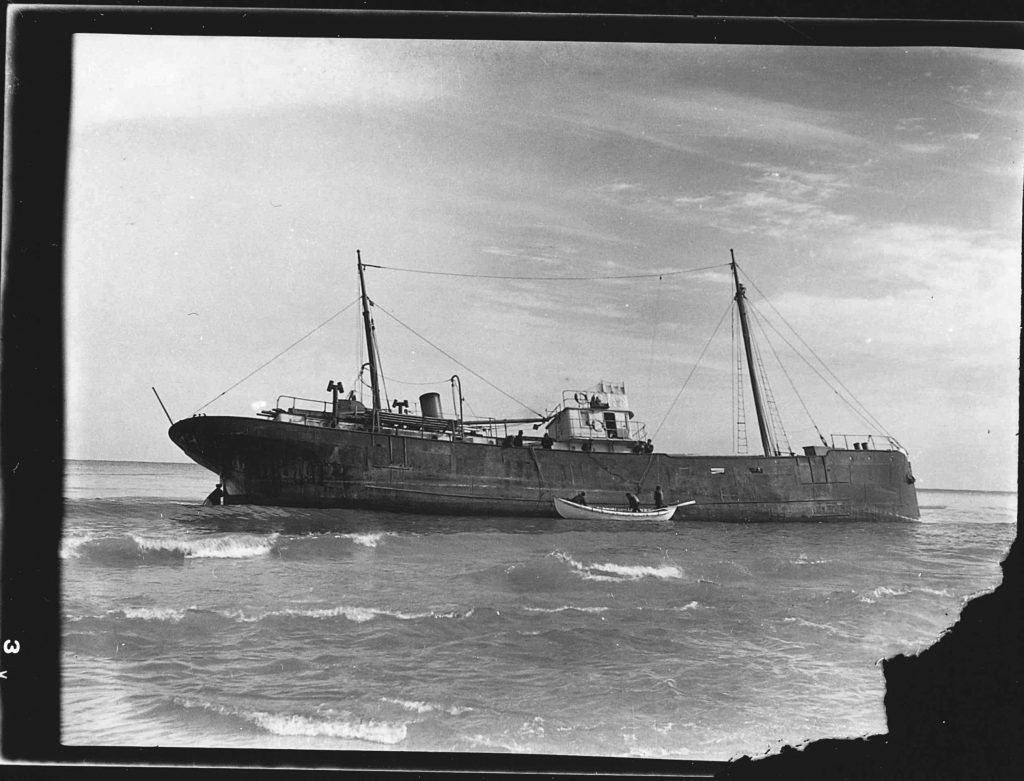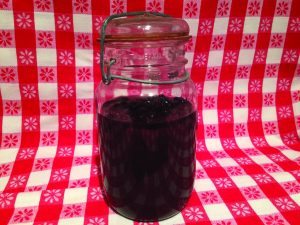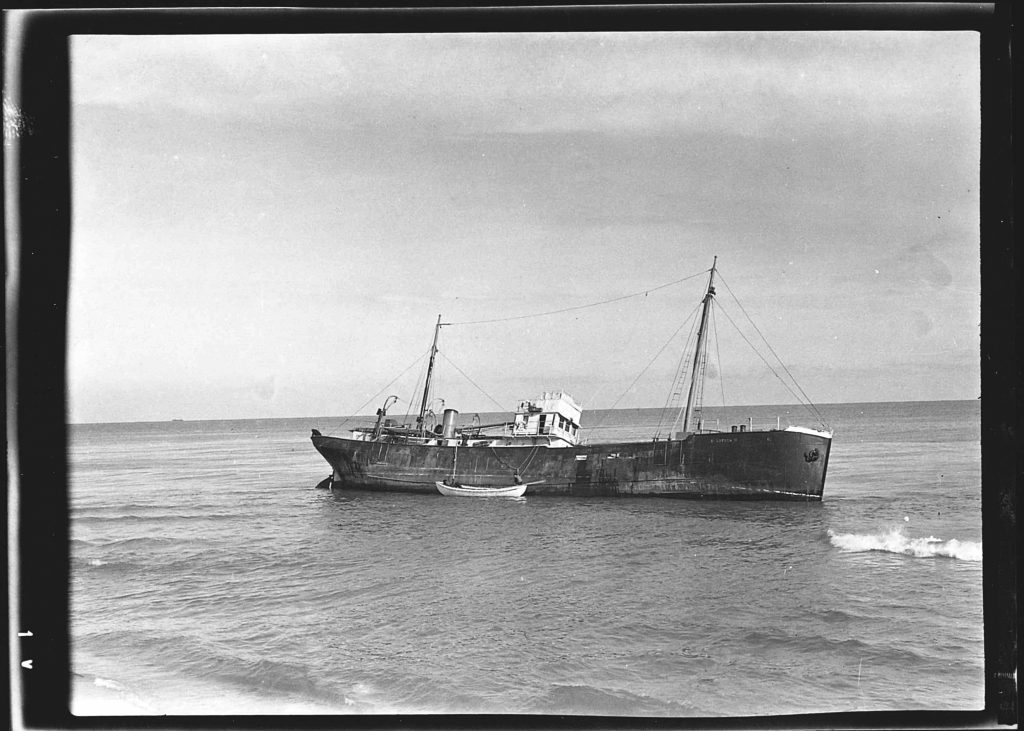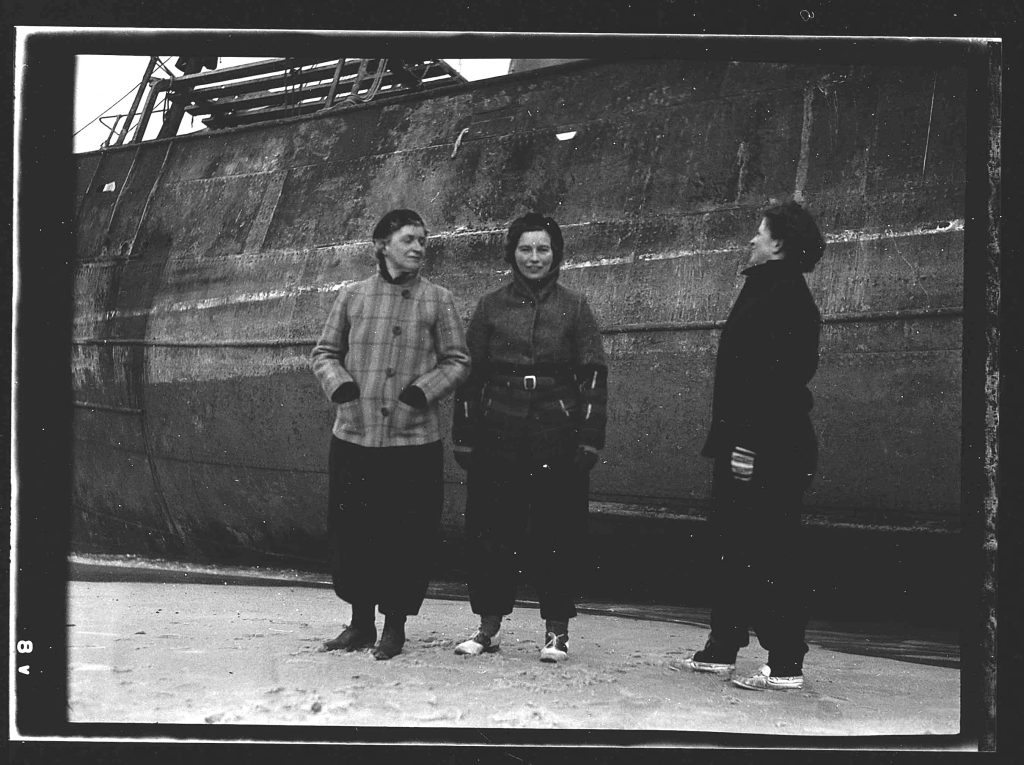
Remembering the Lutzen
Cape Cod Life / July 2015 / History
Writer: Ellen Albanese
Remembering the Lutzen

Cape Cod Life / July 2015 / History
Writer: Ellen Albanese
Recalling the freighter that went aground in a heavy fog off Chatham in 1939

Photo by: The Orleans Historical Society
In February of 1939, Lewis W. Eldredge, 23, of Orleans went down to Nauset Beach to see what all the fuss was about. “A fellow asked me if I wanted a box of blueberries,” Eldredge recalled in an oral history interview conducted by the Orleans Historical Society in 1977. “Well, I thought I was getting a little quart of blueberries. Lord, he brought—it must have had 20 quarts or more . . . ”
The blueberries represented the biggest part of the cargo on the Canadian freighter Lutzen, which ran aground near Nauset Beach in a heavy fog during the early morning hours of Friday, February 3, 1939. The ship was on its way from Halifax, Nova Scotia, to New York City loaded with frozen salmon, 100 barrels of cod liver oil, and 230 tons of frozen blueberries.
In the aftermath, one seaman perished. Baxter Bailey of Trinity, Newfoundland, drowned when the lifeboat he was in capsized shortly after being lowered. Another crewmember in the boat—Newton Halsyard, 33, of St. John’s, Newfoundland, the mate of the Lutzen—was pulled to safety. Stories suggest that the two were headed to shore to get help.

Photo by: The Orleans Historical Society
The captain of the ship, Robert J. Randell, 34, blamed the fog, a strong westerly current, and magnetic forces for the crash. He said he passed by Highland Light in Truro and Nauset Light in Eastham in heavy fog without seeing either one. The area was known for being hazardous. An article in the Daily Boston Globe on February 3 noted that, “the Lutzen grounded in the vicinity of several other wrecks where particularly dangerous bars are located.” And the Chatham Monitor reported that, “the tragedy occurred within 100 yards of the spot where the Boston trawler, Andover, grounded in late December [1938].”
The wreck of the Lutzen, a 155-foot steel-hulled refrigerator craft, drew spectators to the Cape Cod coast for days as attempts were made to pull the ship back out to sea and, failing that, to save the precious cargo.
It seems the blueberries, from St. John’s, New Brunswick, were considered the prize part of the cargo; on the second day after the ship ran aground, the cod liver oil barrels were broken open and tossed overboard to lighten the load. On February 5, 1,000 pounds of frozen fish were removed. Strong winds, though, made it impossible to run a line from the stranded vessel to two Coast Guard cutters waiting offshore to pull it back out to sea.

Photo by: The Orleans Historical Society
By February 6, hope of refloating the ship was abandoned, and some 50 local men were hired to offload the cargo; they were paid 75 cents an hour and were supervised by Coast Guard and customs officials. While the cargo was carefully guarded, there seemed little hope of saving the blueberries, since heavy freezer trucks could not travel over several miles of sandy beach.
Hundreds of people witnessed the salvage operation, and many automobiles became embedded in the soft sand and had to be pulled out by wreckers, according to articles published that week by the Cape Cod Standard Times. Onlookers also reported seeing several large rodents, which had been living in the hold of the Lutzen, appear on deck, then make their way to shore across the hawsers attached to the boat.
The Lutzen capsized in heavy seas on February 7. The following day, the Daily Boston Globe reported that 200 tons of blueberries were taken off the ship, “and are being trucked over three miles of sand beach to Orleans for shipment to New York.” But Cape Cod author and historian, the late William Quinn, opined in his book Shipwrecks Around Cape Cod (1973) that “many of the berries ended up in Outer Cape blueberry pies.”
The Lutzen was built in 1918 at Fort Williams, Ontario, and used as a trawler in the English Channel during World War I. The ship had carried blueberries before. In 1938, the Lutzen delivered 6,000 30-pound boxes of frozen berries to Greater Boston dealers, and made a similar delivery of berries to Philadelphia in 1937.
The Lutzen went aground between the Old Harbor and Orleans Coast Guard stations, two of the 13 life-saving stations built on Cape Cod during the late 1800s. According to the Chatham Monitor, a surfman from the Orleans station, Edgar Dorion, was on beach patrol when he saw the ship’s distress and fired a flare even before the captain could raise the alarm. The crew of the Old Harbor Station, under the command of Chief Boatswain Charles R. Ellis, removed the Lutzen’s crew by surfboat. In addition to Captain Randell and Halsyard, the crew included C.R. Moore, James Gibbons, Arthur Amanson, Frederick Candow, all of St. John’s, New Foundland; Joseph Carew of Cape Croyle, Newfoundland; and Clayton Pelley of Port Union, Newfoundland.

Photo by: The Orleans Historical Society
The wreck was national news. Stories appeared in newspapers in New Hampshire, Pennsylvania, and Florida. The event also made communications history: On February 4, the Cape Cod Standard Times noted, “modern science made itself known along the wastes of Atlantic beachline yesterday as what was probably the first telephone picture to be sent from this section was wired to Boston.” A photographer from Wide World Photos had captured images at the scene, then developed them in the darkroom of a local photographer, Richard Upham, of Chatham, and wired the photo to Boston on a telephone line.
In his 1973 book, Quinn wrote that the hull of the Lutzen still sat in the water just north of the Old Harbor Life Saving Station, and was visible from the air at low tide. An aerial photograph in November of 2010 captured an image of the outline of a ship beneath the waves off North Beach Island in Chatham close to where the Lutzen went down. Quinn—who died in 2014—speculated at the time that the ship might have been the Andover, or perhaps the Lutzen. Whether or not one can locate the ship’s remains today, visitors can still get a glimpse of those blueberries: The Orleans Historical Society has a mason jar of the berries, canned by Addie Williams of Skaket, in its archives.
Ellen Albanese is a freelance writer who lives in Waquoit.



